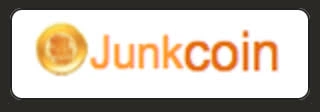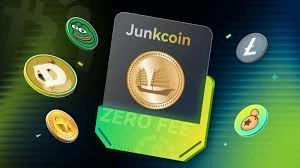Junkcoin (JKC) Cryptocurrency: The Grandfather of Memecoins
Table of Contents

Junkcoin is a Mineable Token. Are you curious about expanding your crypto portfolio with other mineable tokens or alternative coins? At Niftyfinances, you’ll find in-depth information, guides, and the latest updates on a variety of promising crypto projects. Whether you’re a miner or an enthusiast looking for unique opportunities, Niftyfinances is your go-to platform to discover what’s next in the world of decentralized finance!
Did you know that in the vast universe of cryptocurrencies, some coins were created purely for fun? Enter Junkcoin (JKC), launched in 2013 as one of the pioneering memecoins. Initially designed to fail, it defied expectations and has been resurrected by a passionate community. Let’s dive into the intriguing journey of JKC and see how you can become part of this legacy!

What is Junkcoin (JKC)?
Junkcoin (JKC) is a cryptocurrency that originated in May 2013 as a fork of Litecoin, initially created as a joke. Despite its humorous beginnings, it has maintained a presence in the crypto community and underwent a significant revival in 2024.
Key Features of Junkcoin (JKC):
- Proof-of-Work (PoW) Consensus Mechanism:
- JKC utilizes the Scrypt algorithm for its PoW consensus, similar to Litecoin, ensuring efficient and secure transaction processing.
- Dynamic Mining Difficulty Adjustment:
- Employing the DigiShield algorithm, JKC adjusts its mining difficulty after every block. This dynamic adjustment maintains a consistent block time of one minute, even amidst significant fluctuations in hashing power.
- Lottery-Style Bonus Blocks:
- A distinctive feature of JKC is its “lottery-style” bonus blocks, introducing an element of chance into the mining process:
- 1% chance to receive triple the standard block reward.
- 0.01% chance to receive 50 times the standard block reward.
- This mechanism adds excitement for miners, offering the possibility of higher rewards.
- A distinctive feature of JKC is its “lottery-style” bonus blocks, introducing an element of chance into the mining process:
- Controlled Supply and Halving Schedule:
- Following a core update in January 2025, JKC implemented a new mining model with a more controlled and sustainable supply. The initial two years feature frequent reward halvings, which then gradually slow over time, ensuring the coin becomes scarcer while keeping mining incentives attractive.
- Community-Driven Development:
- JKC operates without a centralized team or predefined roadmap, relying on its community of “Junkies” for development, support, and promotion. This decentralized approach emphasizes the role of the community in the coin’s evolution.
- Wallet Options:
- Users can manage their JKC holdings through various wallet options:
- Core Wallets: Suitable for advanced users, offering full control over nodes and transactions.
- Web Wallet (JunkieWally): A browser-based wallet providing a user-friendly interface for managing JKC.
- Paper Wallet: For those preferring offline storage solutions.
- Users can manage their JKC holdings through various wallet options:
Junkcoin’s blend of humor, innovative features, and dedicated community has allowed it to endure in the cryptocurrency landscape, transforming from a lighthearted experiment into a project with historical significance and ongoing development.

The Origins of Junkcoin (JKC)
Birth in 2013
Junkcoin (JKC) was launched in May 2013 as a fork of Litecoin, making it one of the earlier cryptocurrencies in the digital asset space. Designed to be lighthearted and humorous, its creators intended it as a playful commentary on the growing number of altcoins being released at the time.
Intended as a Joke, but Gained Traction
Despite its origins as a joke, JKC resonated with a small yet dedicated community of crypto enthusiasts who appreciated its simplicity and unique features. The project’s tongue-in-cheek approach didn’t prevent it from gaining traction, as miners and users were drawn to its accessible design and fun “lottery-style” mining rewards.
Role as a Precursor to Memecoins
Junkcoin holds a special place in crypto history as a precursor to other memecoins, including Dogecoin, which launched later in December 2013. Like JKC, Dogecoin also began as a joke but went on to achieve widespread fame. Junkcoin’s existence paved the way for a playful and experimental era in cryptocurrency, where projects with humor and community-driven values could flourish.

Junkcoin’s Unique Position in Crypto History
Junkcoin (JKC) holds a special place in the cryptocurrency world as both a pioneer and an influencer. Despite its humorous origins, it established a legacy that shaped the evolution of memecoins and experimental altcoins.
Family Tree: Grandson of Bitcoin, Son of Litecoin
Junkcoin traces its technical lineage back to Bitcoin, the first-ever cryptocurrency. As a fork of Litecoin, JKC is part of the extended “crypto family tree,” inheriting the simplicity, speed, and efficiency of Litecoin while introducing its quirks.
By adopting Litecoin’s Scrypt algorithm, JKC created a fast and accessible cryptocurrency for miners without the need for energy-intensive hardware like Bitcoin’s SHA-256 mining rigs.
Influence on Subsequent Coins: Luckycoin, Bellscoin, Dogecoin
Junkcoin inspired several coins that followed in its footsteps, each contributing to the diverse landscape of cryptocurrencies:
- Luckycoin (LKY):
Luckycoin adopted the idea of randomized block rewards, adding an element of surprise and excitement to mining. This feature influenced Dogecoin’s early design before it shifted to fixed rewards. - Bellscoin (BELLS):
Another Litecoin-based coin inspired by JKC, Bellscoin brought its playful twist, showcasing Junkcoin’s role in fostering creativity in the early days of crypto. - Dogecoin (DOGE):
Dogecoin, one of the most famous memecoins, was directly influenced by JKC. Both share a focus on community-driven development, humor, and accessibility, but Dogecoin’s viral marketing propelled it into mainstream culture.
Significance as an Early Memecoin
Long before the term “memecoin” became popular, Junkcoin exemplified the lighthearted spirit of the genre. Its tongue-in-cheek branding and lottery-style mining rewards made it a novelty in an industry that, at the time, was dominated by serious technical projects. As one of the first coins to prioritize fun and community over utility, JKC set a precedent for future memecoins, proving that cryptocurrencies could be more than just financial tools, they could also be vehicles for creativity, humor, and community engagement.
Junkcoin’s legacy as a grandson of Bitcoin, son of Litecoin, and inspiration for memecoins like Dogecoin cements its place in crypto history. While it may not have achieved mainstream fame, its influence continues to resonate through the projects it inspired and the community it fostered.
The 2024 Revival: Community-Driven Resurgence
After years of dormancy, Junkcoin (JKC) experienced a remarkable revival in 2024, driven entirely by its passionate community. What began as a lighthearted cryptocurrency in 2013 was given new life, proving the enduring appeal of its playful ethos and its place in crypto history.
Abandonment in 2016 and the 2024 Revival
By 2016, Junkcoin had fallen into obscurity, with development halted and its network left largely abandoned. However, a small but dedicated group of “Junkies” saw potential in reviving the project. In 2024, they organized a community-led effort to continue Junkcoin’s journey without restarting the blockchain, ensuring its historical integrity remained intact.
The revival kicked off with a renewed focus on mining, community engagement, and modernizing the coin’s infrastructure to adapt to the current crypto landscape.
Introduction of New Core Wallet (v3)
As part of the revival, the JKC community launched a new core wallet, v3, in January 2024. This wallet update introduced:
- Improved Security Features: Ensuring a safer environment for transactions and coin storage.
- Enhanced User Interface: Making it easier for both new and experienced users to interact with the JKC network.
- Modern Compatibility: Updating the wallet to work seamlessly with modern operating systems and wallets.
The v3 wallet became a symbol of Junkcoin’s fresh start, offering tools to help users reconnect with the network.
Emphasis on Community Involvement and Donations
Junkcoin’s revival emphasized the importance of community-driven development. With no centralized team or official roadmap, its future lies in the hands of its community. Key initiatives include:
- Community Voting: Decisions about the network’s direction and updates are made collectively by its members.
- Charity and Donations: The JKC revival includes a renewed commitment to supporting charitable causes, aligning with the playful yet meaningful ethos of the project. A portion of community funds is allocated to charitable initiatives voted on by the Junkies.
The revival highlights the collaborative power of decentralized communities, demonstrating that even a “joke coin” can thrive with a shared vision and collective effort.
The 2024 revival of Junkcoin underscores the power of community in breathing new life into dormant projects. With a modern wallet, active participation, and a renewed mission, JKC is carving out a place for itself in the evolving cryptocurrency landscape.
Understanding JKC’s Economic Model
Junkcoin’s economic model, or “Junkenomics,” is a testament to its unique and playful approach to cryptocurrency. By combining traditional coin supply mechanics with innovative features like lottery-style bonus blocks, JKC offers an engaging and fair system for miners and users alike.
Total Supply and Distribution
Junkcoin’s total supply is capped, ensuring scarcity and long-term value for its holders. As of its 2024 revival, the community is actively working to refine distribution mechanisms that align with its fair and transparent ethos.
- Controlled Supply: The maximum supply of JKC is carefully designed to maintain a balance between availability and scarcity.
- Fair Mining Rewards: Distribution is tied directly to mining efforts, emphasizing fairness and accessibility for all participants.
Halving Schedule and Its Implications
Junkcoin employs a halving schedule, similar to Bitcoin, to regulate its supply growth and encourage long-term participation:
- Frequent Halvings in Early Years: In its first two years post-revival (2024–2026), JKC introduced frequent reward halvings. This was intended to stabilize the supply quickly while maintaining mining incentives.
- Gradual Halving Over Time: Beyond the initial phase, the halving schedule slows, ensuring rewards continue for miners while making the coin scarcer over time.
- Implications: Halving reduces inflation, promoting scarcity and potentially increasing the value of JKC over time, incentivizing early adopters and long-term holders.
Lottery-Style Bonus Blocks in Mining
One of Junkcoin’s most exciting and unique features is its lottery-style bonus block rewards, adding an element of randomness and fun to the mining process:
- Standard Mining Rewards: JKC offers predictable block rewards for miners.
- Bonus Rewards: Miners have a chance to earn higher rewards through randomly triggered bonus blocks:
- 1% Chance: Earn 3x the standard reward.
- 0.01% Chance: Earn 50x the standard reward.
- Purpose: This gamified approach makes mining Junkcoin more engaging and gives miners a chance to earn significant rewards, even with modest hashing power.
The lottery-style rewards differentiate Junkcoin from other PoW coins, adding excitement and encouraging more diverse participation in the network.
How to Acquire and Store Junkcoin (JKC)
Getting started with Junkcoin (JKC) is simple and accessible to both new and experienced cryptocurrency users. This guide covers where to acquire JKC, how to purchase it, and the best practices for securely storing your coins.
Where to Acquire Junkcoin
Junkcoin is available on several cryptocurrency exchanges, offering different levels of accessibility and features. Below is a list of exchanges that currently support JKC:
- CoinEx: A trusted platform with a straightforward interface for trading cryptocurrencies.
- AscendEX: Known for its advanced trading tools and global user base.
- Nonkyc.io: A privacy-friendly exchange that allows trading without extensive identity verification.
Check the availability of JKC on your preferred platform and ensure that it supports trading pairs like JKC/USDT or JKC/BTC.
How to Purchase Junkcoin Using USDT
Follow these steps to acquire Junkcoin using Tether (USDT):
- Set Up an Account:
- Register on an exchange that supports JKC, such as CoinEx, AscendEX, or Nonkyc.io.
- Complete any required verification process if applicable (e.g., email verification or identity checks).
- Deposit USDT:
- Obtain Tether (USDT) from another exchange or platform if you don’t already have it.
- Transfer USDT to your exchange wallet using the provided deposit address.
- Trade USDT for JKC:
- Navigate to the trading section and search for the JKC/USDT trading pair.
- Place an order:
- Use a market order for instant purchase at the current price.
- Use a limit order to specify your desired price for JKC.
- Confirm Your Purchase:
- After the trade is complete, your Junkcoin balance will appear in your exchange wallet.
Recommended Wallets for Secure Storage
Once you’ve acquired Junkcoin, it’s important to store it in a secure wallet rather than leaving it on an exchange.
- Junkcoin Core Wallet (v3):
- The official desktop wallet was released in 2024 as part of Junkcoin’s revival.
- Features enhanced security, compatibility with modern operating systems, and a user-friendly interface.
- Download from the official Junkcoin website to avoid counterfeit versions.
- Multi-Currency Wallets:
- Coinomi Wallet: A popular mobile and desktop wallet that supports a wide range of cryptocurrencies, including Junkcoin.
- Trust Wallet: Known for its ease of use and mobile-first design, Trust Wallet may support JKC depending on network configurations.
- Cold Storage:
- For long-term holders, consider transferring JKC to a hardware wallet or creating a paper wallet. These offline options provide the highest level of security.
Best Practices for Storing Junkcoin
- Backup Your Wallet: Always back up your wallet’s private keys or seed phrases and store them in a safe location.
- Enable Security Features: Use features like password protection and two-factor authentication (2FA) where available.
- Regularly Update Software: Keep your wallet software up to date to benefit from the latest security patches.
- Avoid Leaving Coins on Exchanges: Exchanges are more vulnerable to hacking. Move your coins to a private wallet for better security.
Acquiring and storing Junkcoin is a straightforward process, with multiple exchange options and secure wallet solutions. By following the steps above, you can safely participate in the Junkcoin ecosystem while protecting your assets.
Mining Junkcoin
Mining Junkcoin (JKC) offers an exciting opportunity for both newcomers and seasoned miners to participate in a playful yet rewarding cryptocurrency network. With its unique features and accessible setup, Junkcoin continues to attract miners looking for a fun and innovative project.
Proof-of-Work Mechanism Using Scrypt
Junkcoin utilizes the Scrypt algorithm for its Proof-of-Work (PoW) consensus mechanism.
- Why Scrypt?
Scrypt is designed to make mining more accessible by relying on memory-intensive computation, reducing the dominance of large mining farms and specialized hardware (ASICs). - Who Can Mine?
Anyone with a GPU or Scrypt-compatible ASIC can participate in mining Junkcoin. This ensures a broad mining community, keeping the network decentralized. - Fair Mining Rewards
Junkcoin’s block rewards include its signature lottery-style bonus blocks, where miners have a chance to earn significantly higher payouts.
Dynamic Difficulty Adjustment with DigiShield
Junkcoin employs DigiShield, an advanced difficulty adjustment algorithm, to ensure a fair and balanced mining process.
- What Does DigiShield Do?
DigiShield dynamically adjusts mining difficulty after every block, rather than on a fixed schedule. This prevents large fluctuations in difficulty caused by sudden changes in mining power. - Why It Matters
- Prevents network instability during sudden surges or drops in hash rate.
- Ensures consistent block times, maintaining the reliability of the Junkcoin network.
- Encourages steady participation from smaller miners by avoiding long periods of excessively high difficulty.
Opportunities for Merged Mining with Litecoin (LTC)
One of Junkcoin’s most notable features is its support for merged mining with Litecoin.
- What Is Merged Mining?
Merged mining allows miners to simultaneously mine Junkcoin and Litecoin (or other Scrypt-based coins) without additional computational power. - Benefits of Merged Mining
- Increased Rewards: Earn JKC alongside LTC rewards, maximizing profitability.
- Shared Security: The network benefits from Litecoin’s hashing power, making Junkcoin more secure and resilient.
- Getting Started
To participate in merged mining, miners simply need to configure their mining software to include both Junkcoin and Litecoin in their operations. Most mining pools that support Litecoin also enable Junkcoin merged mining.
Mining Junkcoin is a rewarding experience that combines accessibility, dynamic difficulty adjustment, and the excitement of lottery-style rewards. With the added advantage of merged mining with Litecoin, miners can maximize their returns while contributing to the growth and security of the Junkcoin network.
Junkcoin’s journey from a 2013 joke to a revived community-driven project is a testament to the unpredictable nature of the crypto world. Whether you’re intrigued by its history or eager to mine and trade, Junkcoin offers a unique experience. Join the Junkie family today and be part of this ongoing legacy!